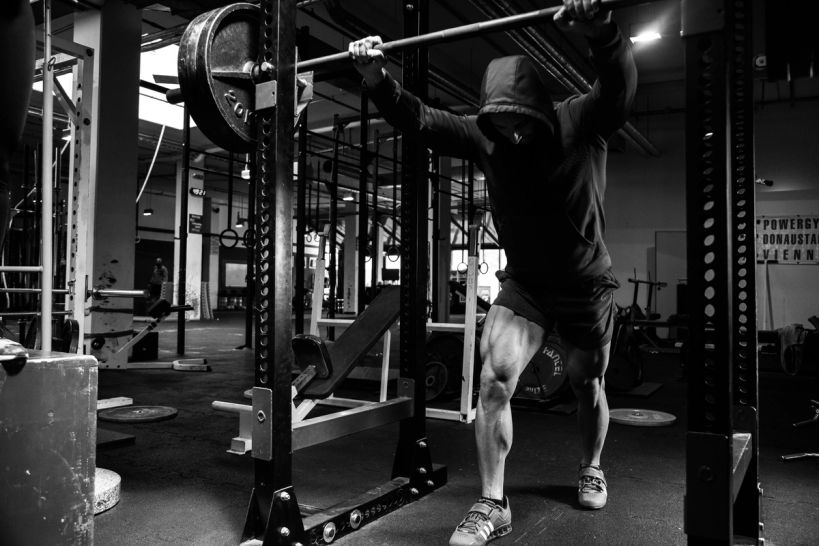Importance of Stretching Before A Workout
Introduction
Have you ever been so excited to hit the gym that you dive straight into your workout without a moment's thought about stretching? Trust me, we've all been there. It's easy to get caught up in the adrenaline rush, wanting to jump right into those heavy lifts or cardio sessions. But before you do, let me tell you why taking a few minutes for some pre-workout stretching is absolutely crucial. Stretching is often underestimated and overlooked as part of a fitness routine, but its importance cannot be emphasized enough. It's like the warm embrace your muscles need before embarking on an intense workout session. Just as you wouldn't start a car in freezing weather without giving it time to warm up, your body deserves the same care and attention. Picture this: You're at the gym, all pumped up and ready to crush your goals. You head straight for the squat rack, load up those plates, and descend into position. But suddenly, something feels off—a twinge in your hamstring that quickly escalates into unbearable pain. You realize then that neglecting pre-workout stretching was a grave mistake. This scenario highlights one of the main reasons why stretching before exercising is essential: injury prevention. When muscles are cold and tight, they are more susceptible to strains and tears when subjected to intense physical activity. By incorporating stretching into your routine, you prepare your muscles for action and reduce the risk of these potential setbacks. But stretching isn't just about avoiding injuries—it offers an array of other benefits too. By taking a little extra time for gentle pre-workout stretches, you can optimize both your physical performance and mental state during exercise.
Understanding Stretching
Defining Stretching and its Purpose
Stretching, my friend, is the act of intentionally lengthening our muscles to increase flexibility and range of motion. It involves gently pulling or elongating your muscles beyond their normal resting length. Now, you might wonder why it's so crucial before a workout. Well, its purpose is to warm up the body, prepare the muscles and joints for action, and reduce the risk of injuries during physical activity. When we stretch, we send signals to our bodies that it's time to loosen up those tight muscles and get ready for some action! This can improve performance during exercise and make movements smoother. By stretching regularly before workouts, you'll notice that your body becomes more limber over time.
Exploring Different Types of Stretches
There are various types of stretches that you can incorporate into your pre-workout routine. Let's dive into some popular ones! 1. Static stretching: This type involves holding a stretch at a comfortable position for 15-30 seconds without any bouncing or movement. It helps relax muscles while increasing their flexibility gradually. 2. Dynamic stretching: Unlike static stretching where you hold a position, dynamic stretches involve continuous movement through a full range of motion. Think about leg swings or arm circles – these are great examples of dynamic stretches that warm up your body by mimicking movements performed during the workout. 3. Proprioceptive neuromuscular facilitation (PNF): Fancy name alert! PNF is an advanced technique often used in rehabilitation settings but can also be beneficial before workouts. It involves contracting a muscle group before stretching it further to enhance flexibility and range of motion.
The Benefits of Incorporating Each Type
Now that we know about the different types of stretches, let's explore why incorporating each one into your pre-workout routine is a wise choice. Static stretching is excellent for elongating tight muscles and increasing overall flexibility. It helps reduce muscle tension and enhances your joint's range of motion. By spending time on static stretches before workouts, you're giving those muscles a chance to loosen up and perform better during exercise. Dynamic stretching, on the other hand, prepares your body for movements that you'll encounter during the workout itself. By mimicking those actions, you're warming up the specific muscle groups involved and improving their elasticity. This can result in more efficient movement patterns and better performance overall. When it comes to PNF stretching, it takes things to a whole new level! By contracting and then relaxing the targeted muscles, you're tricking them into stretching even further than usual. This technique increases both flexibility and strength simultaneously, making it particularly beneficial for athletes or individuals looking to push their limits. Remember, variety is key here! Incorporating all three types of stretches into your pre-workout routine allows you to reap the benefits from each approach. So next time before getting into any serious physical activity, don't skip on these fantastic stretch variations – they'll truly elevate your performance!
Physical Benefits of Stretching
Enhancing flexibility and range of motion for better exercise performance
Stretching plays a crucial role in enhancing flexibility and range of motion, which directly translates into improved exercise performance. When your muscles are flexible, they can move through a wider range, allowing you to perform exercises with greater ease and efficiency. For example, if you have tight hamstrings, it can limit your ability to perform exercises like squats or lunges properly. By regularly stretching those muscles, you will gradually increase their flexibility, enabling you to perform these exercises with better form and effectiveness.
Elaborate on how improved flexibility aids in preventing injuries during workouts
One of the key benefits of increased flexibility is injury prevention during workouts. When your muscles are flexible, they are less prone to strains or tears that can happen when performing exercises that require sudden movements or quick changes in direction. By improving your body's overall flexibility through regular stretching sessions before a workout, it allows your muscles to adapt better to the stress placed upon them during various movements. This increased adaptability reduces the likelihood of injuries such as muscle pulls or sprains. Furthermore, enhanced muscular flexibility helps maintain proper alignment and joint mechanics during exercise. When muscles are too tight or imbalanced in their length-tension relationship, it can lead to altered movement patterns that put excessive stress on joints and ligaments. Regular stretching promotes optimal muscle length and tension balance throughout the body, ensuring that movements occur with proper alignment and reducing the risk of joint-related injuries.
Discuss how increased range of motion optimizes muscle activation and strength gains
Having an increased range of motion (ROM) due to regular stretching sessions positively impacts muscle activation and strength gains during workouts. Greater ROM allows for deeper contractions within muscle fibers when performing exercises. This means that more muscle fibers are recruited to complete a movement, leading to improved muscle activation and ultimately greater strength gains over time. Additionally, a wider ROM allows for better engagement of muscles at various points throughout an exercise. For instance, during a bicep curl, having better flexibility in the elbows and shoulders permits a more extensive stretch at the bottom of the movement. This extended stretch activates more muscle fibers, leading to increased muscle development and strength. Moreover, increased ROM also enhances the effectiveness of resistance training exercises. When muscles can move through their complete range without restriction or discomfort caused by tightness, they can generate more force and power during each repetition. This heightened force production leads to enhanced muscular strength and overall performance. Stretching before a workout offers numerous physical benefits that positively impact exercise performance. By enhancing flexibility and range of motion through regular stretching sessions, individuals can prevent injuries by promoting optimal muscle length-tension relationships. Additionally, increased ROM optimizes muscle activation and enables greater strength gains during workouts. Incorporating stretching into your pre-workout routine not only helps you perform exercises more effectively but also contributes to long-term fitness progress while reducing the risk of injury.
Mental Benefits of Stretching
Reducing Stress and Promoting Relaxation Before Exercise
When it comes to preparing for a workout, it's not just about warming up your muscles; it's essential to also get your mind in the right state. Stretching plays a significant role in reducing stress and promoting relaxation before exercise. As you engage in stretching exercises, you'll notice a soothing effect that washes over you, helping you leave behind the worries and anxieties of the day. Stretching activates the parasympathetic nervous system, which is responsible for our body's rest-and-digest response. This activation induces calmness by lowering heart rate and blood pressure, allowing your body to shift into a more relaxed state. By taking a few minutes for gentle stretches before diving into intense physical activity, you create space for tranquility to take hold.
Endorphins: The Mood-Boosting Powerhouses
One remarkable aspect of stretching is its ability to release those delightful chemicals known as endorphins. Endorphins are natural painkillers produced by our bodies that bring about feelings of euphoria and pleasure while decreasing sensations of stress and pain. Stretching stimulates the release of endorphins, giving your mood an instant boost even before your workout begins. As endorphins surge through your system during stretching, they help alleviate any tension or negativity lingering within you. This rush of happiness can enhance motivation and focus, making your workout all the more enjoyable. So next time you find yourself feeling down or lacking energy before exercising, remember that a good stretch session can be just what you need to lift your spirits.
Finding Focus Through Stretching
Apart from reducing stress and enhancing mood with endorphin release, stretching also plays a pivotal role in sharpening mental focus. While engaging in stretching exercises, you bring your attention to the present moment, taking note of the sensations in your body and the gentle movements you perform. This mindfulness practice can help quieten a cluttered mind and bring you into a state of heightened awareness. By focusing on your breath and being fully present during stretching, you train your mind to let go of distractions and worries that might hinder your workout performance. Stretching becomes a form of meditation, allowing you to cultivate a clear mindset and channel your concentration towards the upcoming physical activity. So when it's time to hit the gym or engage in any physical endeavor, incorporating stretching as part of your routine can provide that mental clarity needed for optimal performance. Stretching is not only about preparing the body physically for exercise but also about nurturing mental well-being before diving into vigorous activity. The act of stretching activates the parasympathetic nervous system, inducing calmness and relaxation. It also triggers the release of endorphins, instantly boosting mood and reducing stress. Additionally, by practicing mindfulness during stretching sessions, individuals can enhance their focus and enter a state of heightened awareness. So remember, take those few minutes to stretch before workouts not just for physical benefits but also for mental rejuvenation – it's an investment in both body and mind!
Injury Prevention through Stretching
Stretching plays a vital role in injury prevention before engaging in any physical activity. By incorporating stretching into your pre-workout routine, you can effectively prepare your muscles for the upcoming exertion, thus reducing the risk of strains or tears. When you stretch, it helps to increase blood flow to the muscles, which in turn warms them up for the activity ahead. When you stretch and blood flow improves, oxygen and nutrients are delivered more efficiently to your muscles. This warming effect helps to loosen up tight and stiff muscles while also making them more pliable. Consequently, your muscles become better prepared for movement and less susceptible to sudden strain or rupture during intense exercise. Furthermore, stretching not only benefits individual muscles but also improves joint stability and balance. It enhances the flexibility of tendons and ligaments surrounding joints, allowing them to accommodate a wider range of motion without excessive stress. By improving joint stability through regular stretching exercises, you can reduce the risk of joint-related injuries like sprains or dislocations.
Tailoring Your Pre-Workout Stretching Routine
Creating a customized pre-workout stretching routine allows you to optimize its benefits while minimizing any potential harm caused by improper execution. To start with an effective stretch session, follow these general guidelines:
- Suggest specific stretches targeting major muscle groups: Focus on stretches that target key muscle groups relevant to your workout routine. For example, if you're planning on running or cycling, prioritize stretches for calves, quadriceps, hamstrings, and hip flexors.
- Emphasize the importance of proper form and gradual progression: Remember that correct posture is crucial during stretches as it ensures optimal muscle engagement while minimizing strain on joints. Start with gentle movements and gradually increase the intensity to avoid sudden strain or injury.
Common Mistakes to Avoid When Stretching Before a Workout
While stretching provides numerous benefits, it's essential to be aware of common misconceptions and avoid potential pitfalls:
- Avoid bouncing or ballistic stretching: Many people mistakenly believe that bouncing during a stretch can increase flexibility quickly.
However, this type of stretch, known as ballistic stretching, can lead to muscle tears. Stick to static or dynamic stretches instead.
- Don't hold your breath: Breathing is often overlooked during stretching exercises, but it is crucial for relaxation and efficient oxygen supply. Breathe deeply and naturally throughout each stretch.
- Avoid overstretching: It's important to find a balance between reaching your limits and pushing beyond them. Overstretching can lead to muscle strains or even joint dislocations.
Conclusion
Incorporating proper stretching techniques into your pre-workout routine is an essential aspect of achieving optimal performance while minimizing the risk of injuries. By preparing your muscles through stretching, you increase blood flow, improve joint stability, enhance flexibility, and reduce the likelihood of strains or tears during exercise. To make the most out of your pre-workout stretches, follow general guidelines such as targeting major muscle groups and emphasizing proper form with gradual progression. Additionally, remember to avoid common misconceptions like bouncing stretches or overstretching that may lead to harm rather than benefits. So take a few minutes before your next workout session to engage in a well-designed pre-workout stretching routine. Your body will thank you for it, and you'll be rewarded with improved performance and a reduced risk of injuries. Stretch smart, move well, and unleash your full potential!
About The Author


Get your macronutrients breakdown
Fill out the form below to get a preview of your recommended daily calorie and macronutrient breakdown.

Stubborn Subcutaneous Fat Loss | 3 Tips
Stubborn Subcutaneous Fat Loss | 3 Tips Introduction When it comes to shedding those stubborn pounds, one particular type of fat seems to be particu...

Keeping A Fitness Journal to Find Your Perfect Routine
Keeping A Fitness Journal to Find Your Perfect Routine Introduction Have you ever felt like you're wandering aimlessly in the world of fitness, unsu...



